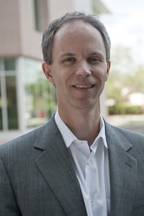Cloudy with a chance of sudden death
BY JADE BOYD
Rice News staff
Bioengineers from Rice University and physicians from Emory University are going to test whether a new “law of biology” can predict when a critically ill patient is about to worsen, and more importantly, which treatment is likely to prevent it.
“We want to arm doctors with a forecasting tool,” said Rice’s Michael Deem, the principal investigator on a new $1.5 million grant from the National Institutes of Health (NIH). “To forecast the weather, meteorologists use the laws of physics and observed data from the atmosphere. Our idea is similar. We plan to use a law of biology and observed data from a patient — like an electrocardiogram (EKG) — to predict what’s about to happen to that patient.”
The new study stems from research Deem began in 2005 as part of a 20-investigator team funded by the Defense Advanced Research Projects Agency’s FunBio program. The goal of that project was to find fundamental laws of biology — similar to the physical laws of motion that were discovered by Isaac Newton in the 1600s. Deem, the John W. Cox Professor of Biochemical and Genetic Engineering and professor of physics and astronomy, found a likely candidate for a biological law of nature in 2007. Like Newton’s second law and Einstein’s law of relativity, Deem’s 2007 law is represented as an equation with just three variables. Written PE=M’/R, Deem’s equation describes the relationship between a system’s structural complexity, or modularity (M’), and its ability to thrive (R) in the face of environmental stress (PE).
“Modularity is a selected trait because it allows a system — be it a gene, a cell, an organ or a whole ecosystem — to adapt to a changing environment,” said Deem, an investigator at Rice’s BioScience Research Collaborative. “The more modular a system, the greater its ability to withstand environmental stress.”
The idea of developing individualized health forecasts — like those planned for patients in the upcoming NIH study — arose while Deem and colleagues searched for proof that the new law could explain what was observed in biological systems. They found the equation could explain observations from genomics, microbiology, physiology and ecology. It even explained some patterns of activity in the global trade network.
The evidence for one of their physiological tests was based on a study by critical-care physician Tim Buchman of Emory University’s Center for Critical Care. Buchman and colleagues used EKGs to monitor the heart activity of subjects undergoing treadmill stress tests. During the tests, the speed and inclination of the treadmill was increased in increments, with each increase representing a new stress on the subjects’ hearts.
Using Deem’s mathematical theory, Buchman found a pattern of modularity — a kind of hidden signal within the EKG data. This pattern showed how the heart was going to react several minutes later.
“The NIH was intrigued by these results,” Deem said. “With its support, we are attempting to take this further and come up with a powerful mathematical tool, a piece of software that can provide clinicians with a patient-specific ‘forecast.'”
Deem said the approach is feasible, in part, because emergency departments already capture a great deal of data about patients. In some cities, a patient’s heart rate, blood pressure, respiratory pattern and other vital signs are relayed in real time from the ambulance before the patient even arrives at the hospital. Critical-care units collect even more data that could be used to predict a patient’s immediate future.
Emory intensive care unit teams focus on providing the “right care, right now, every time,” said Buchman. “Today’s best critical care aims to mitigate critical illness. With predictive tools based on Michael Deem’s biological law, it’s our hope to forecast and pre-empt life-threatening events. That’s important for patients and their families, but it’s also important for our nation since critical care accounts for such a large fraction of the nation’s health care expenditure.”
Deem said, “This goes beyond making guesses. We’ll be looking for clear, mathematically rigorous methods for finding signals that are embedded inside the data that hospitals are already collecting. We want to provide the patient-specific information that critical-care physicians need to optimize treatment outcomes for individual patients.”


